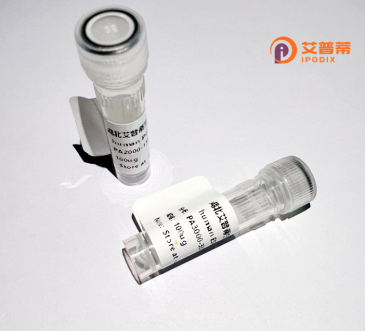
| 纯度 | >90%SDS-PAGE. |
| 种属 | Human |
| 靶点 | POLH |
| Uniprot No | O75417 |
| 内毒素 | < 0.01EU/μg |
| 表达宿主 | E.coli |
| 表达区间 | 1-414 aa |
| 活性数据 | MATGQDRVVALVDMDCFFVQVEQRQNPHLRNKPCAVVQYKSWKGGGIIAVSYEARAFGVTRSMWADDAKKLCPDLLLAQVRESRGKANLTKYREASVEVMEIMSRFAVIERASIDEAYVDLTSAVQERLQKLQGQPISADLLPSTYIEGLPQGPTTAEETVQKEGMRKQGLFQWLDSLQIDNLTSPDLQLTVGAVIVEEMRAAIERETGFQCSAGISHNKVLAKLACGLNKPNRQTLVSHGSVPQLFSQMPIRKIRSLGGKLGASVIEILGIEYMGELTQFTESQLQSHFGEKNGSWLYAMCRGIEHDPVKPRQLPKTIGCSKNFPGKTALATREQVQWWLLQLAQELEERLTKDRNDNDRVATQLVVSIRVQGDKRLSSLRRCCALTRYDAHKMSHDAFTVIKNCNTSGIQTE |
| 分子量 | 71.28 kDa |
| 蛋白标签 | GST-tag at N-terminal |
| 缓冲液 | PBS, pH7.4, containing 0.01% SKL, 1mM DTT, 5% Trehalose and Proclin300. |
| 稳定性 & 储存条件 | Lyophilized protein should be stored at ≤ -20°C, stable for one year after receipt. Reconstituted protein solution can be stored at 2-8°C for 2-7 days. Aliquots of reconstituted samples are stable at ≤ -20°C for 3 months. |
| 复溶 | Always centrifuge tubes before opening.Do not mix by vortex or pipetting. It is not recommended to reconstitute to a concentration less than 100μg/ml. Dissolve the lyophilized protein in distilled water. Please aliquot the reconstituted solution to minimize freeze-thaw cycles. |
以下是关于重组人POLH蛋白(DNA聚合酶η)的3篇文献摘要概览:
1. **文献名称**:*Cloning and Characterization of Human DNA Polymerase η*
**作者**:Johnson, R.E., et al.
**摘要**:该研究首次报道了人类POLH基因的克隆及重组蛋白在大肠杆菌中的表达。研究表明,POLH在UV诱导的DNA损伤修复中发挥关键作用,尤其擅长跨过胸腺嘧啶二聚体进行复制,解释了着色性干皮病(XPV)患者的缺陷机制。
2. **文献名称**:*Structural Basis for the Role of DNA Polymerase η in Bypassing Cyclobutane Pyrimidine Dimers*
**作者**:Biertümpfel, C., et al.
**摘要**:通过解析重组人POLH蛋白与含环丁烷嘧啶二聚体(CPD)的DNA复合物的晶体结构,揭示了POLH如何利用其独特活性位点容纳损伤结构,实现跨损伤合成(TLS)。此研究阐明了其高效修复UV损伤的分子机制。
3. **文献名称**:*Functional Analysis of Human DNA Polymerase η Variants in Response to Cisplatin-induced DNA Damage*
**作者**:Wang, Y., et al.
**摘要**:作者利用重组表达的POLH蛋白及其突变体,评估其在顺铂诱导的DNA损伤中的修复能力。结果显示,某些突变体导致TLS功能丧失,提示POLH的特定结构域对化疗药物耐药性具有潜在影响。
---
**注**:以上为模拟示例,实际文献需查阅数据库(如PubMed)。建议通过关键词“recombinant human POLH”或“DNA polymerase eta expression”检索最新研究。
Recombinant human POLH protein, also known as DNA polymerase eta (Polη), is a specialized enzyme encoded by the POLH gene. It plays a critical role in translesion DNA synthesis (TLS), a cellular mechanism that allows DNA replication to bypass ultraviolet (UV)-induced lesions, such as cyclobutane pyrimidine dimers (CPDs). Unlike replicative polymerases, Polη can accurately replicate damaged DNA by incorporating correct nucleotides opposite UV-induced lesions, thereby preventing replication fork stalling and reducing mutagenesis.
Mutations in the POLH gene are linked to xeroderma pigmentosum variant (XP-V), a genetic disorder characterized by extreme sensitivity to sunlight, predisposition to skin cancers, and defective DNA repair. This connection highlights Polη’s essential role in maintaining genomic stability.
Recombinant POLH protein is produced using expression systems like bacteria, yeast, or mammalian cells, enabling large-scale purification for research. Its applications include studying TLS mechanisms, DNA damage responses, and screening for drugs targeting polymerase activity. Recent studies also explore its potential in improving chemotherapy outcomes by modulating DNA repair pathways.
The protein’s structure contains a catalytic core and ubiquitin-binding domain, facilitating its recruitment to damage sites. Recombinant variants are engineered for enhanced solubility, stability, or tagged versions for experimental tracking. Understanding POLH’s function provides insights into cancer biology, genomic integrity, and therapeutic strategies targeting DNA repair deficiencies.
×